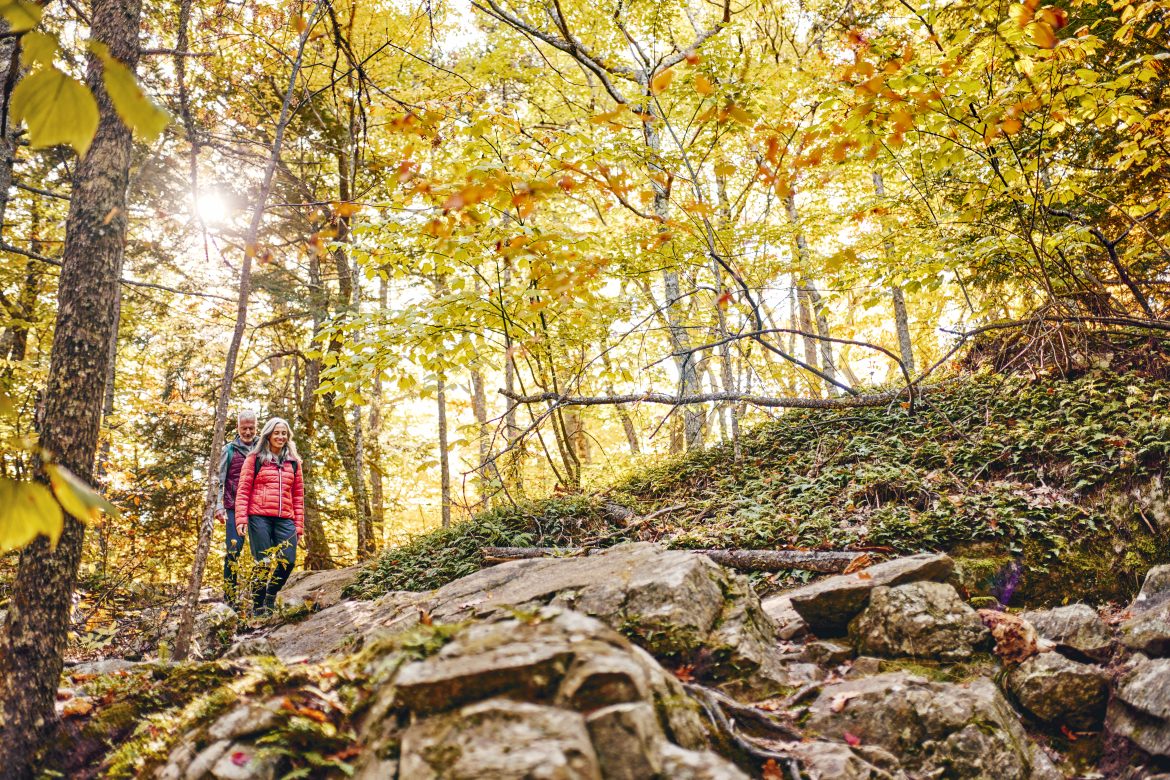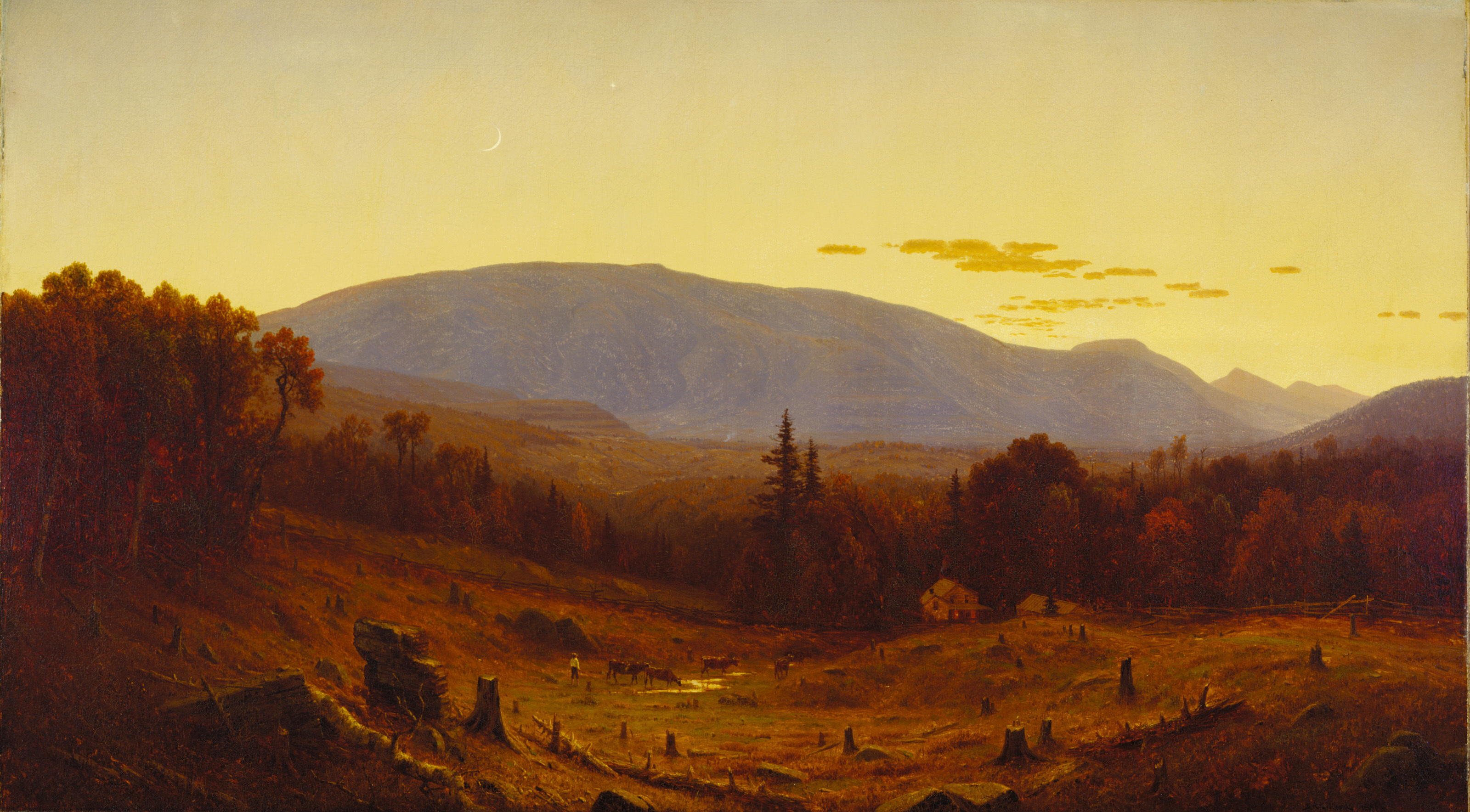In New England, hiking in autumn and winter provides a brisk yet serene escape for nature lovers.
By Lannan M. O’Brien
When fall arrives in New England, the landscape shifts: cooler weather draws us from the shore to the mountains. Ocean views are replaced with wooded trails and a canopy of trees bursting with color. When the temperature drops, each new path leads to a new discovery.
Across the region, parks, reservations, and wildlife refuges offer adventure during the months when we tend to retreat indoors. Countless distinctly New England destinations await to welcome you. So, this fall and winter, why not “take a hike”?
NEW HAMPSHIRE
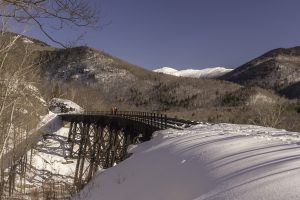
Arethusa Falls – Crawford Notch State Park
New Hampshire’s tallest single-drop waterfall is the centerpiece of this three-mile hike, a stunning sight both when surrounded by fall foliage and after a winter snowfall when the flowing water is frozen in place. Although the trail itself is fairly easy (and known for being family-friendly), hikers recommend MicroSpikes or even snowshoes in winter. Difficulty: Easy
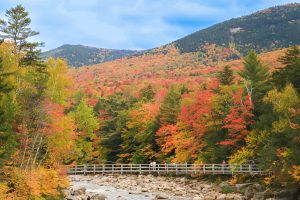
Lincoln Woods Trail – Lincoln
Right off the scenic Kancamagus Highway in the White Mountain National Forest, is Lincoln Woods, home to a network of trails that include this roughly three-mile path along an old logging railroad grade. Views of the Pemigewasset River and its often-photographed suspension footbridge make this easy walking trail a favorite, as well as side trails to the picturesque Black Pond and Franconia Falls. Difficulty: Easy
Lonesome Lake Trail – Franconia
Hikers who brave this steep trail up Cannon Mountain will be rewarded when they reach the shores of the beautiful Lonesome Lake, backed by mountain views. Located in Franconia Notch State Park, this vigorous hike through the Franconia Ridge requires a bit of extra gear in the winter, such as hiking poles and ice cleats for safety. Trust us, it’s worth the effort! Difficulty: Moderate
MASSACHUSETTS
Mohawk Trail State Forest – Charlemont
One of the most scenic woodland areas in the state, the 6,000-acre Mohawk Trail State Forest is situated along its namesake—the historic Mohawk Trail auto road— in a mountain gorge. Numerous trails of varying lengths offer something for everyone, such as the moderate 3.4-mile Nature Trail Loop at the Upper Meadow, with views of some of the tallest white pine trees in New England, and the more challenging Indian Trail to Mahican-Mohawk Trail, which follows footpaths originally used by Indigenous Peoples. Multiple trails, varying difficulties
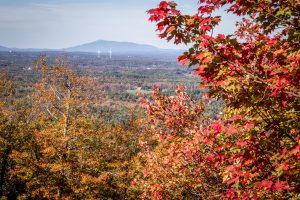
Wachusett Mountain State Reservation – Princeton, MA
Although often associated with skiing, Wachusett Mountain State Reservation is a treasure trove for hikers and mountain bikers, with 17 miles of trails to be discovered. At four miles round-trip, the Old Indian Trail hike that begins at the Balance Rock kiosk ultimately leads to the summit, opening to 360-degree views and a glimpse of the distant Boston skyline. MicroSpikes are recommended in the winter. Difficulty: Moderate
World’s End – Hingham, MA
This 251-acre Trustees of Reservations property features diverse landscapes, from rolling hills to coastal drumlins (“spoon-shaped hills formed by glaciers,” as described by The Trustees). Moderate hikes along the 4.5 miles of carriage paths and footpaths—designed by landscape architect Frederick Law Olmsted—lead to stunning views of the Boston skyline. Difficulty: Moderate
VERMONT
Lye Brook Wilderness – Sunderland
East of Manchester Center, you’ll find Lye Brook Wilderness, a haven for wildlife in the Green Mountains. Once the location of heavy logging, hiking trails pass overgrown railroad grades where timber was transported from a high plateau, before the area became designated wilderness in 1975. Among several footpaths is Lye Brook Falls Trail, featuring the 125-foot-high Lye Brook Falls. (Note: Slippery rocks make climbing the falls dangerous). Difficulty: Moderate
The Pogue and Mount Tom Trail – Woodstock
A quiet and peaceful hike, this loop trail covers just over four miles in Marsh-Billings-Rockefeller National Historical Park, Vermont’s only national park. Known for its historic carriage road system, which was developed by Frederick Billings in the 1870s, these trails are “multi-use” in the winter: hikers may use them for free, with the expectation that they avoid the ski tracks and respect ski- and snowshoeing-only trails. Difficulty: Moderate
Stowe Pinnacle – Stowe
This hike is all about the end goal: a rocky viewpoint surrounded by the Green Mountains, which happens to be one of the most photographed areas in the state of Vermont. Choose from two starting points: Upper Hollow Road (a 3.6-mile hike round-trip) or Pinnacle Heights Road (2.6 miles round-trip). Both lead to the same breathtaking views. Difficulty: Moderate
CONNECTICUT
Air Line State Park Trail – East Hampton
Covering over 50 miles, this rail trail follows a former route from New York to Boston, passing through scenic wildlife preserves and state parks. Varied landscapes—including mountains, streams, and rock formations—are a highlight of this trail system, which is split into two sections: the South, from East Hampton to Windham, and the North, from Windham to Putnam, plus a Thompson addition to the Massachusetts state line. Difficulty: Mostly moderate
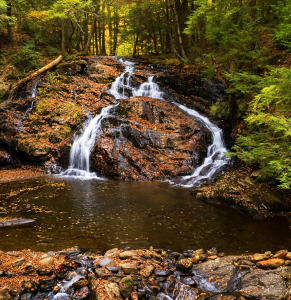
Bear Mountain Loop – Salisbury
With the highest peak in Connecticut (2,354 feet), Bear Mountain is among the most popular hikes in Mount Riga State Park—but it certainly isn’t easy. Steep and rocky, this six-mile loop trail is worth the effort for the views spanning New York, Massachusetts, and Connecticut. Be prepared with appropriate gear (especially in winter), as this hike is known for its scrambles over slick rocks. Remnants of a stone tower are visible at the summit. Difficulty: Hard
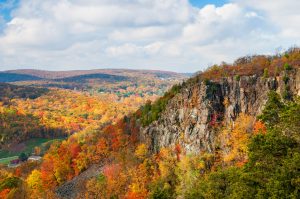
Sleeping Giant State Park – Hamden
This state park is the resting place of the “Sleeping Giant,” a geological landmark of trap rock ridges formed by volcanic eruptions. With 32 miles of backcountry trails, there are myriad options for beginner and advanced hikers alike. Among them is the leisurely, three-mile (round-trip) Tower Path, a wide gravel path leading to the Sleeping Giant Observation Tower with 360-degree views, which, on a clear day, extend to New Haven County and Long Island. Difficulty: Easy
RHODE ISLAND
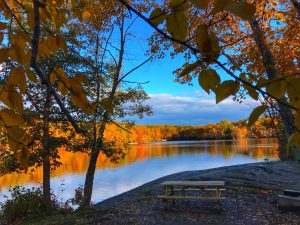
Lincoln Woods State Park – Lincoln
Named for President Abraham Lincoln, Rhode Island’s first state park comprises just over four miles of trails of varying lengths. Recognized for an iconic covered bridge at the Breakneck Hill entrance, this park is a popular spot for recreational activities, from swimming and fishing to hiking and even horseback riding. Lincoln Woods trail, a three-mile loop, is a great family hike that’s perfect for leaf peeping in the fall. Difficulty: Easy
Long Pond Woods Wildlife Refuge – Hopkinton
Bordering Long Pond and Ell Pond, this 220-acre property offers what the Audubon Society of Rhode Island describes as “arguably the most challenging hiking of any Audubon Refuge.” Steep, rocky terrain rewards hikers with bird’s-eye views of Long Pond and plentiful wildlife. Keep an eye out for mink, otters, painted turtles, and myriad bird species along the way. Difficulty: Hard
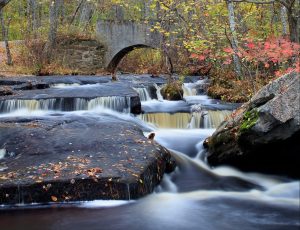
Stepstone Falls via Ben Utter Trail – West Greenwich
This 2.7-mile, out-and-back hike is filled with memorable sights from beginning to end. Ideal for all ages and abilities, the trail features streams and bridges, even passing the remnants of an old gristmill. Eventually, it takes hikers to the rushing waters of the Falls River and its namesake, Stepstone Falls. Difficulty: Easy
MAINE

Acadia National Park – Mount Desert Island
Home to the Atlantic Coast’s tallest mountain, Cadillac Mountain (1,530 feet), Acadia draws visitors from far and wide to its wealth of landscapes, wildlife, and geological features. There’s no shortage of trails: experienced hikers will enjoy the challenging Beehive loop, featuring steep granite staircases and exposed cliff faces, which offers spectacular views of fall foliage, Sand Beach, and the Gulf of Maine (dangerous in inclement weather); for easier hikes, try Day Mountain Trail or the 45 miles of carriage roads. Multiple trails, varying difficulties
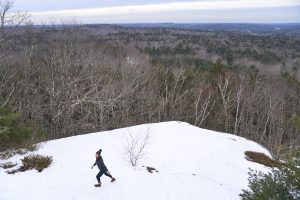
Bradbury Mountain State Park – Pownal
Fall colors are on full display from the peak of Bradbury Mountain. Standing at only 485 feet, the summit offers stunning views of Casco Bay and the Portland skyline. Trails accessed via the west side of Route 9 are the most popular for hiking. From the Northern Loop, a gradual ascent to the summit, catch sight of a feldspar quarry active in the 1920s and a “cattle pound” which, in the 1800s, kept stray animals that wandered onto other farms. Difficulty: Easy

Camden Hills State Park – Camden
Best known for the views atop Mt. Battie—which span Camden Harbor, Penobscot Bay, and the surrounding islands—Camden Hills is a popular destination for camping, hiking, and leaf peeping. The Mt. Battle Trail, although short at just over a mile, is challenging, with steep sections and scrambles over rocks and ledges. A more moderate climb, the Mt. Megunticook trail leads to the park’s highest peak. Multiple trails, varying difficulties

Staying Safe on the Trail
Essential tips for New England hikers in the fall and winter.
Photo and text by Julia Cumes
Hiking in New England during the fall and winter offers a chance to immerse yourself in nature’s serene and majestic beauty. However, these seasons bring unique challenges that demand meticulous preparation and wise decision-making.
“We rescue people with a lot of good gear, thousands of dollars’ worth of clothing, more than one GPS device, and satellite communication,” says Joe Roman, Appalachian Mountain Club (AMC) Backcountry Resource Manager. “They have all the stuff, but they just don’t make the right decisions.”
Will Murphy, president of Androscoggin Valley Search and Rescue (AVSAR), adds, “Hypothermia is the most common reason we go out to rescue people in the fall and winter. What’s going to keep you warm is staying dry,” he says. “So, if you’re sweating in your core and your feet are cold, you have poor thermal management, and this could get you into trouble.”
Realizing you should stop and return to safety can be a life-saving decision. Jeffrey Fongemie, director of the Mount Washington Avalanche Center, advises knowing where you’re going, having turnaround times, researching the weather, trying not to be surprised by anything, and understanding the consequences of your decisions. “Blindly pushing on instead of knowing when to turn around leads to many of the problems we see,” he says.
Expert’s Top Tips for Staying Safe on the Trail:
1. Plan ahead: Research your trail, including its length, difficulty, and terrain. Know your route and set turnaround times.
2. Check the weather: Always check the weather forecast before heading out and prepare for sudden changes.
3. Tell someone your plans: Inform a friend or family member about your route and expected return time.
4. Carry the essentials: Bring a flashlight or headlamp, extra clothing, weatherproof upper and lower layers, a topographic map and compass, additional food and water, matches or a firestarter, a first aid kit and gear
repair kit, a pocketknife, and a whistle.
5. Wear appropriate footwear and dress in layers: Layering helps you manage your body temperature and stay dry. Choose moisture-wicking fabrics for your base layers.
6. Stay hydrated: Even in cold weather, it’s crucial to drink plenty of water.
7. Keep track of time: Days are shorter in fall and winter, so plan to finish your hike well before dark.
8. Watch for ice: Trails can be icy, so consider using traction devices like microspikes.
9. Avoid sweating: Wet clothing can lead to hypothermia. Adjust your layers to prevent excessive sweating.
10. Stay on marked trails: Stick to marked trails to avoid getting lost and protect fragile ecosystems.
Dress appropriately, be mindful of your environment, and make intelligent decisions, and you will be ready to enjoy the best New England has to offer this season.

